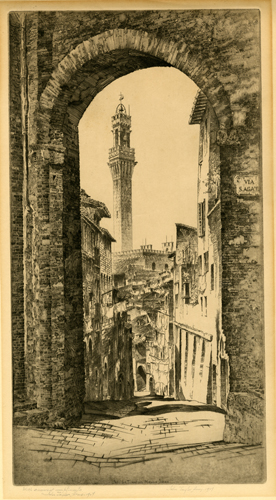Home » Fine Arts Gallery » Traveling Europe Through Art with the Fine Arts Gallery’s Summer Exhibition
Traveling Europe Through Art with the Fine Arts Gallery’s Summer Exhibition
Posted by vrcvanderbilt on Tuesday, June 20, 2017 in Fine Arts Gallery, HART, VRC.
 Siena’s Torre del Mangia in the Piazza del Campo, sunrise at San Remo on the Mediterranean coast, the Roman stone arch bridge of Alcántara spanning the Tagus River at Toledo, and other artfully rendered images of timeless beauty. Featured this summer in the Vanderbilt Fine Arts Gallery is American Artists and the Legacy of the Grand Tour, 1880-1960, an exhibit that explores work created and brought home by American artists, and the continuing allure of Europe as a destination for leisure, study, and cultural refinement during these years.
Siena’s Torre del Mangia in the Piazza del Campo, sunrise at San Remo on the Mediterranean coast, the Roman stone arch bridge of Alcántara spanning the Tagus River at Toledo, and other artfully rendered images of timeless beauty. Featured this summer in the Vanderbilt Fine Arts Gallery is American Artists and the Legacy of the Grand Tour, 1880-1960, an exhibit that explores work created and brought home by American artists, and the continuing allure of Europe as a destination for leisure, study, and cultural refinement during these years.
In a historical sense, the Grand Tour was a seventeenth- to eighteenth-century phenomenon in which young, usually male and aristocratic, members of English and Northern European families visited great cities and societies of the European continent. It was an educational trip, meant largely for cultural exposure and refinement. Art was central to this travel in a number of ways, from visiting masterpieces of painting and architecture, to commissioning portraits, buying art to bring home, and engaging an artist for the journey who would paint the sublime beauty of each destination. This exhibition examines a time from approximately 1880 to 1960 when American artists endeavored to follow in the footsteps of this tradition and trek to Europe for a variety of reasons: study and opportunities to exhibit, illustration on commission, war, and leisure. Education was also a goal of their journey, both for themselves through the process of travel and study and for others through the skills, cultural enlightenment, and artwork they would bring home.
Included in this exhibition are such artists as John Taylor Arms, Otto Henry Bacher, and Alonzo C. Webb, who spent extended sojourns abroad and produced large bodies of work to send back to the United States. Some, like famed illustrator Joseph Pennell and the lesser-known painter Willie Betty Newman, visited Europe to establish a reputation for refinement that would boost their careers back home. While the United States was increasingly becoming more diverse toward the end of the period featured in this exhibit, a majority of Americans could trace their roots to European countries. It follows that studying there was often still viewed as an important part of an artist’s education and a means to develop cosmopolitan tastes, looking to the precedent of many artists in generations past.
 The exhibition includes etchings, engravings, lithographs, and paintings by John Taylor Arms, Otto Henry Bacher, Lionel Barrymore, George Inness, Joseph Pennell, Abbott Thayer, and others as well as paintings by Alonzo C. Webb and Willie Betty Newman loaned by the Tennessee State Museum. Their work documents the architecture, scenery, and people of Italy, the Netherlands, Spain, Greece, England, and France as the artists saw them.
The exhibition includes etchings, engravings, lithographs, and paintings by John Taylor Arms, Otto Henry Bacher, Lionel Barrymore, George Inness, Joseph Pennell, Abbott Thayer, and others as well as paintings by Alonzo C. Webb and Willie Betty Newman loaned by the Tennessee State Museum. Their work documents the architecture, scenery, and people of Italy, the Netherlands, Spain, Greece, England, and France as the artists saw them.
On view now through August 26, the exhibit is organized by the Vanderbilt Fine Arts Gallery and curated by Margaret Walker, assistant curator, with support provided by the Fine Arts Gallery Gift Fund and the Sullivan Art Collection Fund.
The Fine Arts Gallery is located in Cohen Memorial Hall, 1220 21st Avenue South, on the western edge of the Peabody College campus. Summer gallery hours are Tuesday through Friday noon–4 pm, Saturday 1–5 pm, closed Sunday and Monday. Please note that the gallery will be closed on July 4 in observance of Independence Day. Admission to the gallery is free and open to the public.
For more information, please visit the gallery’s website at http://www.vanderbilt.edu/gallery.
*John Taylor Arms (American, 1887-1953), La Mangia, Siena, etching on woven paper, 1927. Gift of Thomas B. Brumbaugh, professor of fine arts, emeritus, Vanderbilt University.
**Abbott H. Thayer (American, 1849–1922), Sunrise, San Remo, oil on canvas, ca. 1908–09. Gift from Dr. A. Everette James in memory of A.E. James Sr.

©2026 Vanderbilt University ·
Site Development: University Web Communications